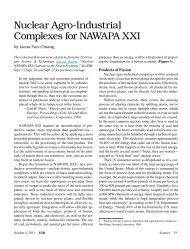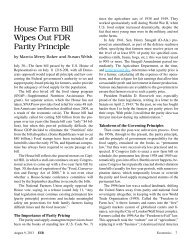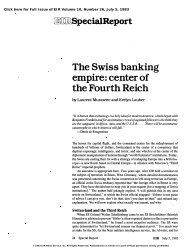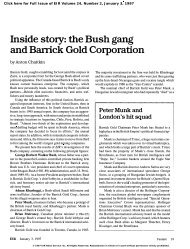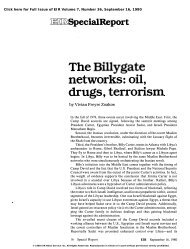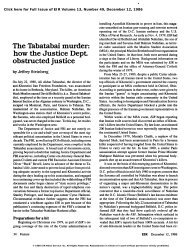View Full Issue - Executive Intelligence Review
View Full Issue - Executive Intelligence Review
View Full Issue - Executive Intelligence Review
Create successful ePaper yourself
Turn your PDF publications into a flip-book with our unique Google optimized e-Paper software.
TABLE 1<br />
More than 40% of Mexican workforce is<br />
unemployed<br />
(in millions)<br />
Year Population E.A.P.* Employed Unemployed % Unemployed<br />
1970 48.2 13.0 12.2 0.8 6.1<br />
1980 66.8 28.1 15.4 6.7 30.3<br />
1985 78.5 24.0 16.8 7.2 30.1<br />
1986 81.0 24.8 15.1 8.7 35.0<br />
1987 83.0 24.9 15.6 9.3 37.5<br />
1988 85.0 25.5 15.1 10.4 40.8<br />
• Economically Active Population<br />
ended with his protest, 14 million Mexicans were born. The<br />
needs of almost half of them were completely unmet, because<br />
government social spending was cut to 1970 levels. The GNP<br />
per inhabitant was reduced 14% and consumption per capita<br />
by 14.3%. The total investment per inhabitant was 35.5%<br />
less.<br />
Thus, by 1994, there will be 24 million children between<br />
the ages of 0 and 12, suffering from malnutrition caused by<br />
the sell-out of De la Madrid to the creditors.<br />
To talk today of the need to create 1 million jobs annually<br />
is pure demagogy which denotes the absence of any serious<br />
intent to solve the unemployment problem. Table 1 shows<br />
the structure of the economically active population. By analyzing<br />
it, the hair-raising conclusion is reached that Mexico's<br />
economy has to provide 2 million productive positions per<br />
year.<br />
The De la Madrid regime generated 1 million unemployed<br />
annually among youth whose expectations for a regular<br />
wage were smashed by the recession it induced against<br />
the economy. Factories and farms closed. With this policy it<br />
threw almost 50% of the labor force into unemployment or<br />
under-employment.<br />
To try to take care of more than 12 million indigents with<br />
the National Social Solidarity Program is a mere chimera.<br />
That could provoke a confrontation between those favored<br />
by the program and those who are kept out of it.<br />
The economy does not grow<br />
President Salinas postulated "a new epoch of growth" in<br />
which "the private sector will play a fundamental role." He<br />
also stated, "The motor for the new growth will basically<br />
come from internal savings." Such growth should translate<br />
into the expansion of the internal market, increasing employment<br />
and gradually strengthening the buying power of wages<br />
and encouraging cooperatives.<br />
On examining where this recovery stage must begin, one<br />
concludes that the actions to be taken are much more difficult<br />
than mere statements.<br />
EIR January 20, 1989<br />
What private sector? Real private investment in Mexico<br />
during De la Madrid's six-year term was negative 17.5%;<br />
real public investment was negative 50.7%; and total real<br />
investment was negative 26.4%. Industry is operating at only<br />
40% of its installed capacity, and that reduced capacity is<br />
further threatened by the lowering of trade barriers and by<br />
the excessive importation of goods which could be produced<br />
inside Mexico.<br />
The De la Madrid regime held Mexico's economy locked<br />
in deep recession which it will be hard to get out of.<br />
In 1983, the GNP fell by 5.3%; in 1984 and 1985 it went<br />
up by 3.7% and 2.7% successively, but it never overcame its<br />
previous decline. In 1986, the GNP fell another 3.6%, then<br />
recovering by 1. 1 % in 1987, only to again drop an estimated<br />
2.0% in 1988 (see Figure 2) .<br />
Mexico does not need "we will grow again" rhetoric; it<br />
needs the parts of its productive aparatus which have been<br />
dislocated by the previous administration's inflationary flogging<br />
to be put back together again.<br />
In 1983, the government promised 50% inflation, but it<br />
FIGURE 2<br />
Mexico's Gross National Product<br />
skids downward under De la Madrid<br />
(billions of constant 1988 pesos)<br />
400<br />
390<br />
380<br />
370<br />
1982 83 84 85 86 87<br />
Sources: Wharton Econometrics and Mexican Planning Secretariat.<br />
At the end of De La Madrid's six years, production was 2% Lower<br />
than at the beginning.<br />
88<br />
Economics 7






